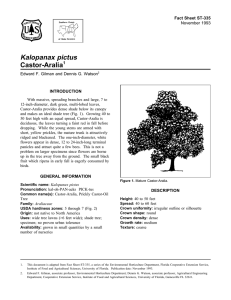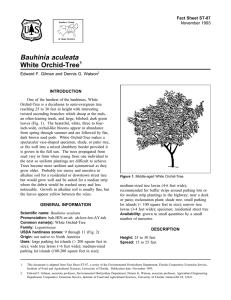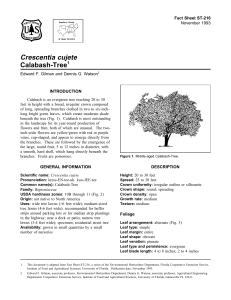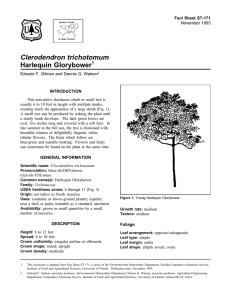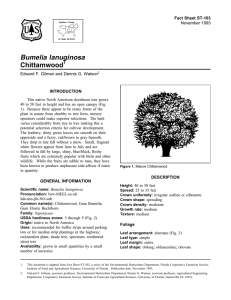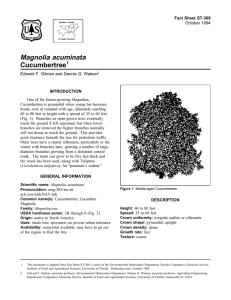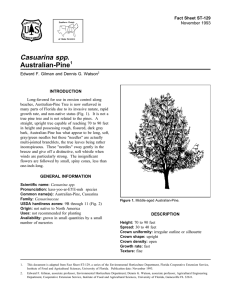Coccoloba uvifera Seagrape Fact Sheet ST-175 1
advertisement
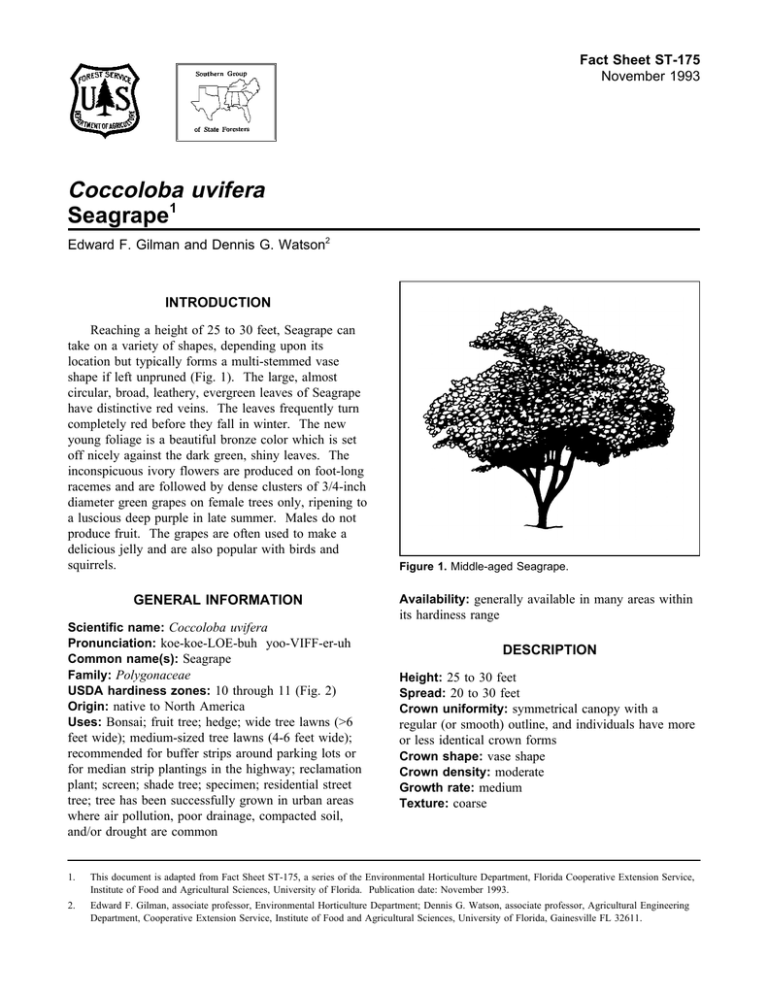
Fact Sheet ST-175 November 1993 Coccoloba uvifera Seagrape1 Edward F. Gilman and Dennis G. Watson2 INTRODUCTION Reaching a height of 25 to 30 feet, Seagrape can take on a variety of shapes, depending upon its location but typically forms a multi-stemmed vase shape if left unpruned (Fig. 1). The large, almost circular, broad, leathery, evergreen leaves of Seagrape have distinctive red veins. The leaves frequently turn completely red before they fall in winter. The new young foliage is a beautiful bronze color which is set off nicely against the dark green, shiny leaves. The inconspicuous ivory flowers are produced on foot-long racemes and are followed by dense clusters of 3/4-inch diameter green grapes on female trees only, ripening to a luscious deep purple in late summer. Males do not produce fruit. The grapes are often used to make a delicious jelly and are also popular with birds and squirrels. GENERAL INFORMATION Figure 1. Middle-aged Seagrape. Availability: generally available in many areas within its hardiness range Scientific name: Coccoloba uvifera Pronunciation: koe-koe-LOE-buh yoo-VIFF-er-uh Common name(s): Seagrape Family: Polygonaceae USDA hardiness zones: 10 through 11 (Fig. 2) Origin: native to North America Uses: Bonsai; fruit tree; hedge; wide tree lawns (>6 feet wide); medium-sized tree lawns (4-6 feet wide); recommended for buffer strips around parking lots or for median strip plantings in the highway; reclamation plant; screen; shade tree; specimen; residential street tree; tree has been successfully grown in urban areas where air pollution, poor drainage, compacted soil, and/or drought are common DESCRIPTION Height: 25 to 30 feet Spread: 20 to 30 feet Crown uniformity: symmetrical canopy with a regular (or smooth) outline, and individuals have more or less identical crown forms Crown shape: vase shape Crown density: moderate Growth rate: medium Texture: coarse 1. This document is adapted from Fact Sheet ST-175, a series of the Environmental Horticulture Department, Florida Cooperative Extension Service, Institute of Food and Agricultural Sciences, University of Florida. Publication date: November 1993. 2. Edward F. Gilman, associate professor, Environmental Horticulture Department; Dennis G. Watson, associate professor, Agricultural Engineering Department, Cooperative Extension Service, Institute of Food and Agricultural Sciences, University of Florida, Gainesville FL 32611. Coccoloba uvifera -- Seagrape Page 2 Figure 2. Shaded area represents potential planting range. Foliage Leaf Leaf Leaf Leaf Leaf Leaf arrangement: alternate type: simple margin: entire shape: orbiculate venation: banchidodrome; pinnate; reticulate type and persistence: broadleaf evergreen; evergreen Leaf blade length: 8 to 12 inches Leaf color: green Fall color: red Fall characteristic: not showy Flower Flower color: white Flower characteristics: inconspicuous and not showy; winter flowering Fruit Fruit Fruit Fruit Fruit shape: round (Fig. 3) length: .5 to 1 inch covering: fleshy color: blue; purple Fruit characteristics: attracts birds; attracts squirrels and other mammals; suited for human consumption; fruit, twigs, or foliage cause significant litter; showy Trunk and Branches Trunk/bark/branches: bark is thin and easily damaged from mechanical impact; droop as the tree grows, and will require pruning for vehicular or pedestrian clearance beneath the canopy; routinely grown with, or trainable to be grown with, multiple trunks; showy trunk; tree wants to grow with several trunks but can be trained to grow with a single trunk; no thorns Pruning requirement: requires pruning to develop strong structure Breakage: susceptible to breakage either at the crotch due to poor collar formation, or the wood itself is weak and tends to break Current year twig color: brown Current year twig thickness: thick Coccoloba uvifera -- Seagrape Page 3 hand pruning, since the large leaves do not lend themselves well to shearing. Pruning is required two or three times during the first 10 years after planting to train the multiple trunks so they are well-attached to the tree. Be sure branches do not develop embedded bark, since they will be poorly attached to the trunk and could split from the trunk. But the wood and the tree is generally very strong and durable following this developmental and corrective pruning. The tree will then perform well with little care, except for occasional pruning of lower branches to create clearance for vehicles. Some people object to the litter created by the large, slowlydecomposing leaves which fall from the tree during the year. Figure 3. Fruit of Seagrape. Requiring full sun and sandy, well-drained soils, Seagrape is excellent for seaside locations since it is highly salt- and drought-tolerant. Plants should be well-watered until established and then should only require occasional pruning to control shape. Culture There is a variegated cultivar available. Light requirement: tree grows in part shade/part sun; Propagation is by seed or cuttings. tree grows in full sun Soil tolerances: clay; loam; sand; acidic; alkaline; well-drained Drought tolerance: high Aerosol salt tolerance: high Soil salt tolerance: good Pests Stems are subject to Seagrape borer which can kill branches. A nipple gall causes raised, red nipples on the upper leaf surface. Other Roots: surface roots are usually not a problem Winter interest: no special winter interest Outstanding tree: not particularly outstanding Invasive potential: little, if any, potential at this time Pest resistance: long-term health usually not affected by pests USE AND MANAGEMENT The contorted, twisting trunk (which can grow to two feet in diameter) and upright branching habit makes Seagrape an interesting, picturesque shade tree or specimen planting or, it can be pruned into a dense hedge, screen, or windbreak. Because of its size and coarse texture, Seagrape as a clipped hedge is more suited to foundation plantings for large buildings where it will lend a tropical effect. It is also used as a seaside hedge in commercial landscapes, but requires Diseases No diseases are of major concern.
